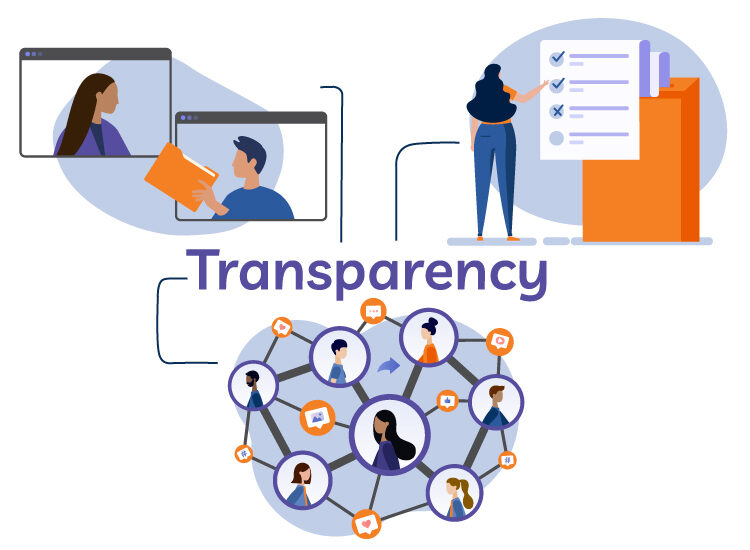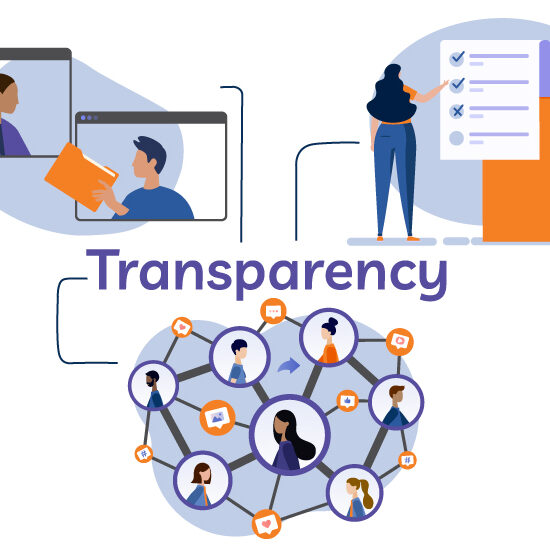Workplace transparency fosters openness between leaders and team members, creating a trust that leads to success. Transparency that brings real change doesn’t come with a one-time initiative — it requires an ongoing effort and a receptive company culture that allows team members to communicate honestly with management, and feel that their opinions and ideas are valued.
A 2018 poll reported by Forbes found that 86 percent of Americans think business transparency is more important than ever. More than 70 percent felt their managers didn’t share enough information, and half of those asked believed a lack of transparency was holding their company back.
What is Workplace Transparency?
Transparency in the workplace refers to truthful, two-way communication between management and team members. Without transparency, the workforce may feel unappreciated, uninformed, and powerless. Taking time to build transparency into company culture can bring benefits like increased employee satisfaction and higher productivity. It will also help attract and retain quality job candidates.
Productivity is bound to take a hit when team members don’t feel they are being treated honestly and openly. When everyone is on the same page about an organization’s vision, values and goals, then everyone’s efforts will move in the same direction. In addition, each team member will have a good understanding of what is expected in their role and how they contribute to the big picture.
According to Craig Cincotta, a senior director of communications at Microsoft, “When you get people talking and sharing, you open up a network for new ideas and better ways to run the business…By promoting ways for employees to have a voice and for staying connected with each other, you are able to create not only a culture of transparency but a responsive organization as well.”
There are so many benefits associated with having a transparent workplace that it’s well worth the effort involved. These three steps can help build a transparency culture in any organization.
Share Important Information
Regular all-hands meetings held weekly or bi-monthly provide a way for team members to learn about what’s going on in the company, including current priorities. Missed opportunities and obstacles should also be reported, although discretion may be required for negative news that’s sensitive in nature. A hands-on meeting is also an excellent place to celebrate recent wins, make general announcements and recognize team members who have made significant contributions.
Hands-on meetings should provide a safe space for providing feedback and getting answers to questions. Besides all-hands meetings and team meetings, managers must be available and open for feedback and discussion. Performance reviews should be seen as a learning opportunity for both management and team members. When leaders are transparent and candid, team members will be motivated to strive for the same level of openness.
Support Anonymous Feedback
Hands-on meetings and one-on-ones with managers are essential tools for establishing transparency, but some people are more comfortable providing anonymous feedback. A physical or virtual suggestion box provides a safe mechanism for submitting suggestions and complaints without fear of reprisal. Informal polls and surveys are also effective ways to solicit anonymous feedback. To make the process meaningful, there needs to be a plan for communicating ideas that have been suggested and the actions that have resulted.
Feedback may not always be positive but dissenting opinions shouldn’t be ignored. Transparency cannot include censorship or punishment for expressing unpopular ideas. Instead, management must find a way to allow team members to communicate freely.
Provide an Office Networking Tool
The most transparent organizations encourage open communication at all levels. A networking tool that allows everyone to stay connected is essential for company-wide transparency. This is especially important for remote workers who can’t drop in on other team members for informal face-to-face discussions. Providing a platform for sharing and discussion helps create a culture of transparency where everyone has a voice.
An added benefit of increased communication is the generation of new ideas about increasing productivity or finding new sources of revenue. This, in turn, makes team members feel more involved and engaged in the enterprise. Team members who feel informed are more likely to be satisfied with their job and less likely to waste time with company gossip and speculation.
If you would like to learn more about a tool that can create transparency throughout your company, contact coAmplifi today.




